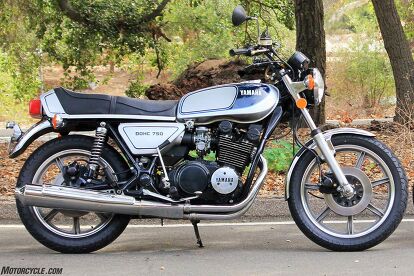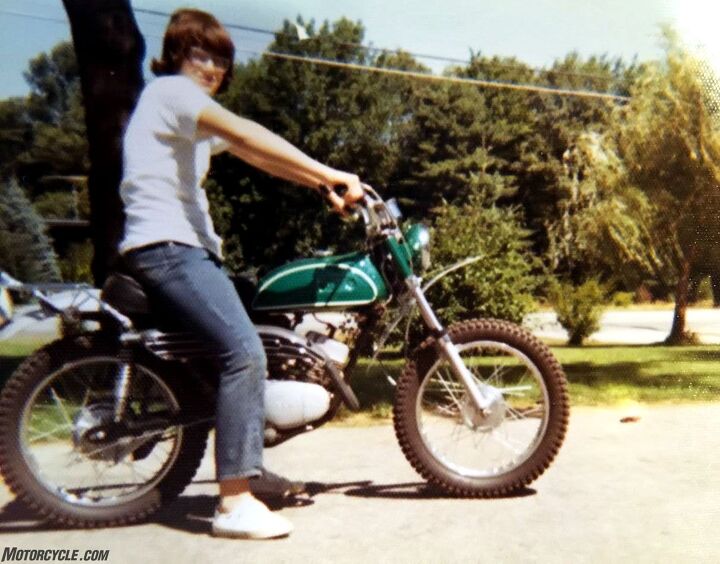Serendipity Finding A Vintage Motorcycle: Starr-Crossed Lovers
Rider makes deep connection with Yamaha XS750 separated by 3000 miles and 40 years
“If I ever go looking for my heart’s desire again, I won’t look any further than my own back yard. Because if it isn’t there, I never really lost it to begin with.”
A motorcyclist’s search for the ideal classic motorcycle often makes for interesting stories. The story of Bob Starr’s XS750 is even more fascinating than most. It’s an engagement that spans the country and four decades, and it ends up being discovered where it all began.
Starr is in many ways a typical baby-boomer gearhead who has loved motorbikes since he was a kid and still rides today as often as time allows. Well, he’s typical aside from his occupation as Corporate Communications Manager for Yamaha Motor Corporation USA.
“I’ve told a lot of people that it’s a rare thing that you can turn a passion that you have at an early age and turn it into a lifetime career,” observes Starr, “and I’m fortunate I’ve been able to do just that. And my enthusiasm for riding hasn’t diminished whatsoever.”
Unsung Motorcycle Heroes: Bob Starr
The tale of Starr’s love of motorcycling and his XS750 goes back to New Hampshire in the late 1960s when he purchased his first dirtbike at age 12 from money earned working on a farm. A rotating list of streetbikes moved through his hands after getting his driver’s license in the mid-1970s, but, surprisingly, never a Yamaha.
Starr enrolled in business courses at the University of New Hampshire in 1974, and he also got a job at a local moto dealership to help pay his bills. Around the same era, Yamaha was developing its three-cylinder GX750 in an effort to keep pace with four-cylinder Hondas and Kawasakis that were blowing the minds of speed freaks in the 1970s. The GX was introduced in 1975 for the ’76 model year, and it, at the time, had the most cylinders ever in a Yamaha engine. Soon after, Yamaha renamed it the XS750C for export markets and replaced wire wheels with cast aluminum hoops.
Silver XS750Ds were rolling off the Yamaha assembly line in the summer of ’76 as 1977 models, the XS’s first year of availability in the U.S. One of them was sold in Massachusetts, presumably for a price near its $2236 MSRP, and it would eventually find its way to California four decades later.
Meanwhile, Starr was taking undergraduate college courses while working at another motorcycle dealership, graduating in 1978 with a business/economics degree and advancing up the ranks at the dealership from mechanic to sales to part-time general manager. He made a foray into roadracing in 1979 with the American Association of Motorcycle Road Racers (AAMRR), sharing the pits at Loudon with legendary local racers like Mike Baldwin and Rich Schlachter.
“I completely immersed myself in motorcycling and the culture,” Starr fondly reminisced. “It was everything to me.” Starr bought a new streetbike every year from 1976 until ’81, but still no Yamahas…
In 1980, that silver XS750D in Massachusetts had 5000 miles on its clock and was sold to its second owner who lived in a tiny New Hampshire town. Mont Vernon had a population of less than 1500 then, which makes it a synergistic coincidence that one of them was Bob Starr.
Starr continued working at his local dealership after graduating college before being hired as a district sales manager for Suzuki in 1982. Four years later, Starr was lured to the West Coast as Suzuki’s assistant advertising manager. Around the same time, that silver XS750D in New Hampshire was ridden for the last time by its owner, who planned to quickly fix tip-over damage but never got around to it. It was moved from his garage to his basement, where it sat for the next three decades.
Starr was much busier than his future bike, stepping up to Suzuki’s ad manager for a few years before being hired at Cycle World for an 18-month stint as advertising director. Then, in 1992, Starr began his quarter-century association with Yamaha, beginning as motorsports marketing manager.
Fast forward to 2015, and the owner of the XS750 decides it’s time to get it out of his basement and sell it to someone who will put it back on the road. Dunking its rusty gas tank in 5 gallons of cider vinegar cleaned it up, but its motor wouldn’t turn over with its kickstarter. Soaking it in Mystery Oil for several weeks helped break it loose.
Meanwhile, Starr is feeling nostalgic about vehicles from his youth. Having a steady supply of new motorcycles at his workplace, Starr looked in the direction of a car to satisfy his wistfulness for vehicles from his juvenescence. A Saab 900 Turbo convertible with a manual transmission fit the bill.
“We’re spoiled by all these modern conveniences,” Starr notes. “In this (Saab), you actually have to push a lever to the floor and grab another lever and move it from gear to gear, and it’s fun. For me and for a lot of people, there’s an attraction to the memories of when you were first learning to drive or to ride, and it’s fun to look back at those times.”
After stepping back in time with his Saab story, thoroughly enjoying the experience, Starr began to seriously consider a vintage motorcycle. A Yamaha from the 1970s was a gaping hole in the long list of streetbikes he’s owned, and he immediately knew it would have to be an XS750.
“I had a number of different streetbikes in the late 1970s, but I never had a Yamaha. And when I decided I wanted to buy something, this was the first bike I wanted to look at.”
The three-cylinder XS750 would be a perfect fit for Starr, as his employer had recently launched a trio of enticing new Triples, the FZ-09, FJ-09 and XSR900. An XS750 would bring the Yamaha chain full circle for Starr. But the synchronicity wouldn’t end there.
Starr’s search for a cherry XS750 wouldn’t be limited only to his SoCal environs – he went national, checking into various classified ads and forums to hopefully find the perfect bike. He found an ideal example, ironically, in his former hometown of Mont Vernon.
“Talk about a really small world that I would find this bike in the same town I lived in when I was buying all these bikes in the 1970s,” Starr says incredulously about the XS he found, adding the previous owner even knew where Starr’s old family house is located. “I could probably have walked from my (old) house to pick it up – it was that close!”
The XS had only 9006 miles on its odo when Starr had it shipped to California. It initially was running only on two cylinders, but carburetor rebuilds (by a good friend and another longtime Yamaha employee) and new spark plugs put the proper spring back in its step. Taking no chances with safety, the brakes were rebuilt with new pistons and pads, both of which were still available from Yamaha. So were the fork seals, which are the same rubber sliders used on Yamaha’s TT-R230! Fresh Bridgestone S22 rubber was spooned on the wheels.
“I spent a week on and off just cleaning it,” Starr proudly says. “I’ve been doing management-type things at Yamaha for a number of years, and it felt really good to get my hands dirty. Working on it and with your hands cleaning the 40 years of history off of it and knowing it’s been on the backroads of New Hampshire where I grew up, that means a lot.” However, Starr’s intention was never to create a museum queen.
“My goal was I wanted it to be like it was back in the period,” Starr relates. “I wanted it to be like I bought it in 1985 and just started riding it. The importance of this kind of heritage is so you can enjoy it much as it was back 40 years ago, and I’m real happy that the bike has that. It’s bringing the memories back and creating more memories again when you get it running.”
Going back in time can sometimes be a rude awakening when looking back with rose-colored glasses, but Starr says there were absolutely no disappointments with his vintage motorbike.
“It runs way better than I ever thought it was going to,” the former New Englander boasts, though he acknowledges its chassis isn’t quite up to modern standards. “It sounds good and it performs well. I’m amazed at how well it performs.”
Duke’s Den: 1977 Yamaha XS750 Review (Of Sorts)
For Starr, his XS750 does the expected job of transporting him back in time to when his love for motorcycles was most intense.
But the overarching story here isn’t just a middle-aged guy connecting with nostalgia. It’s especially about the various connections that have all unexpectedly come together.
“This bike makes that connection back to that time in my life for me,” Starr says. “It draws it all together. It’s connected to what I’m doing now in the heritage of Yamaha, it’s connected to my youth, it’s connected to where I grew up – it compresses all the memories within those 40 years.
“The fact that I got it out of New Hampshire, the same town where my love for motorcycling was born and matured, that’s ironic that of all places that I would find it there. And then to make the connection from across the country. It’s amazing!”
More by Kevin Duke






















































Comments
Join the conversation
I bought a new XS850, and put a Pacifico Aero frame mount fairing on it. Nice bike, but right after the warranty expired it would shift up into 5th gear and then wouldn't downshift. Rode it from SoCal to Oakland in the pouring rain, stopped at the Denny's in Fresno, and left squishy wet footprints over to the lunch counter.
Back in the 70s I had 2 of the XS 750 E model [twin mufflers] which had CDI [a big improvement] and went very well, had great brakes and handled well [on UK Dunlop K91 tyres as I recall] - the triple engine was great, easily serviced including shims [using the simple tool] and gave me a lifelong soft spot for triples. Biggest improvement was fitting Koni DialA Rides, so Bob can get a set from Ikon in Australia [cheap as chips] and enjoy his 'new' ride even more!!